
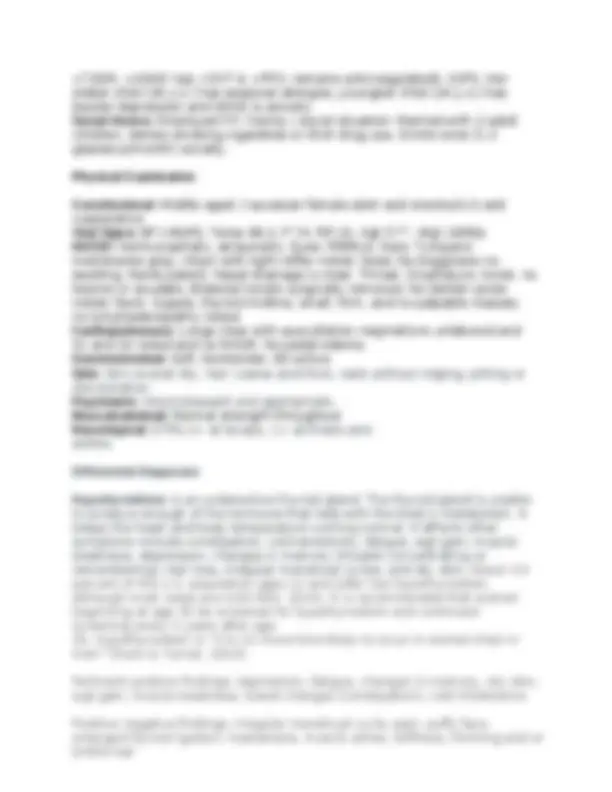

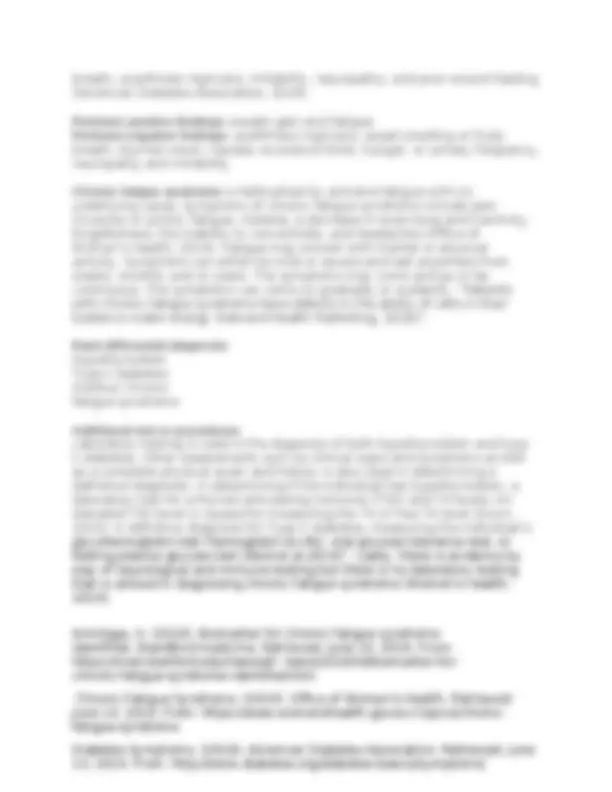

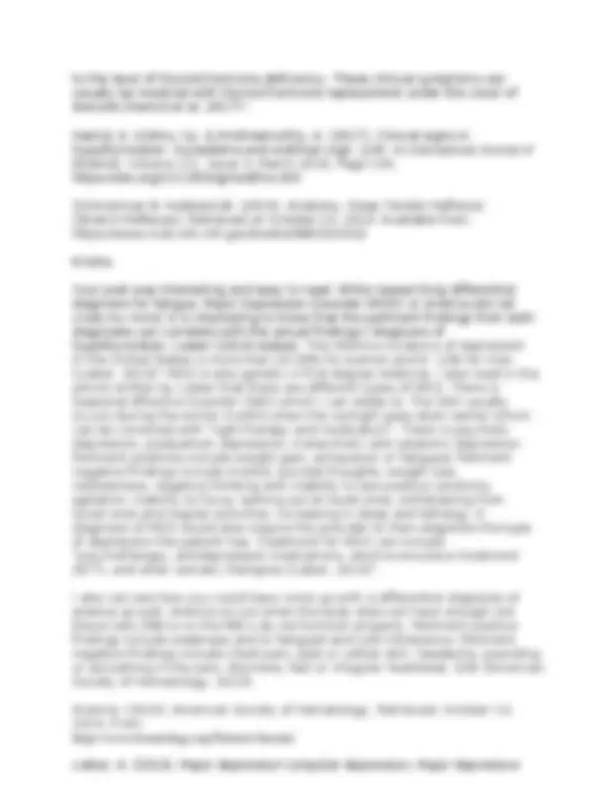

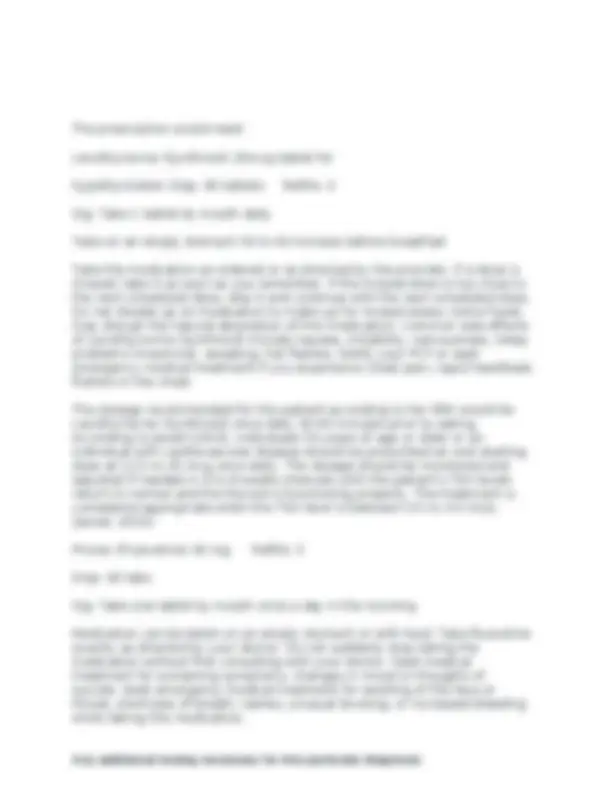
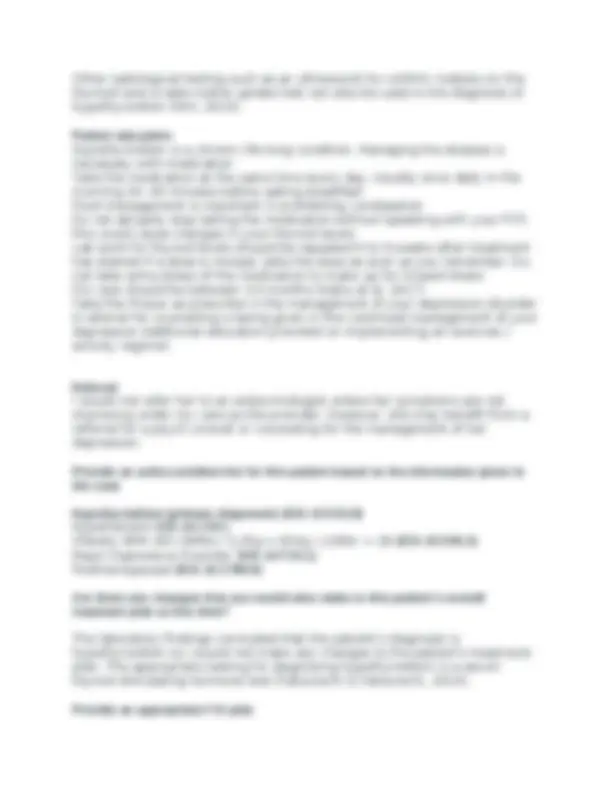
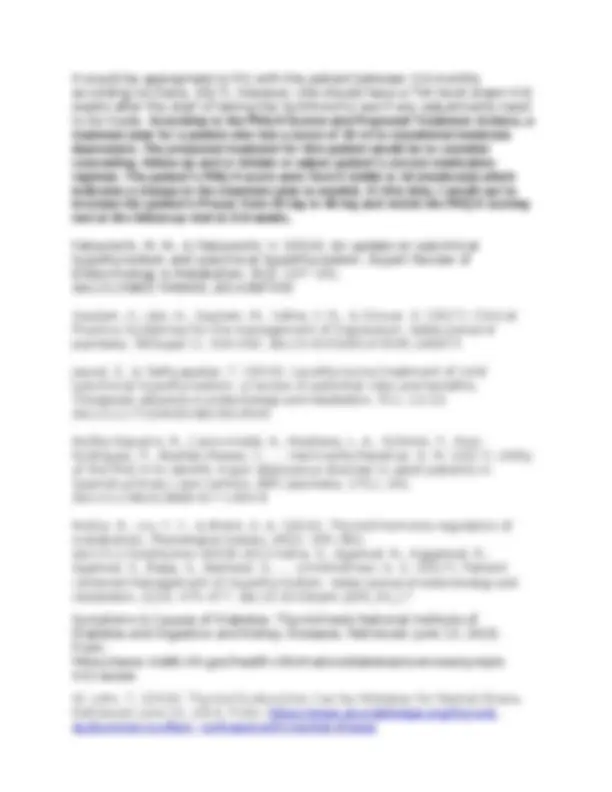
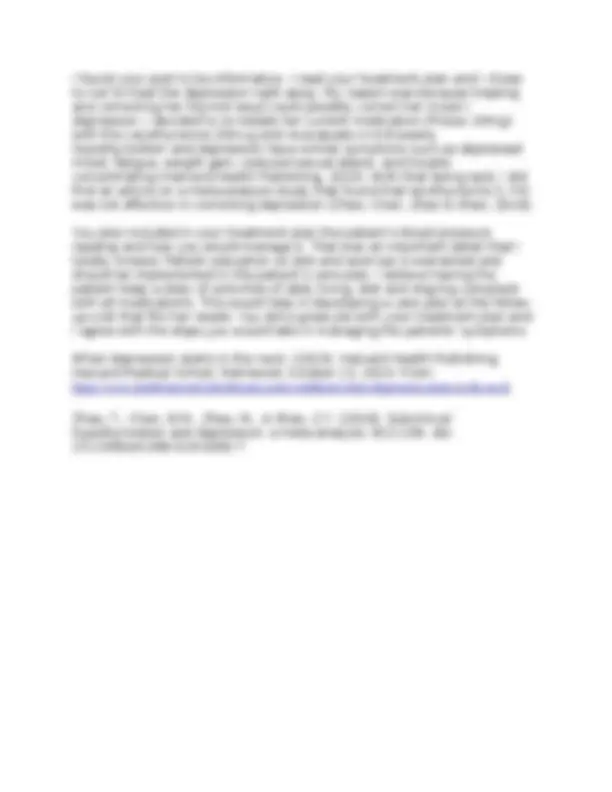


Study with the several resources on Docsity

Earn points by helping other students or get them with a premium plan


Prepare for your exams
Study with the several resources on Docsity

Earn points to download
Earn points by helping other students or get them with a premium plan
Community
Ask the community for help and clear up your study doubts
Discover the best universities in your country according to Docsity users
Free resources
Download our free guides on studying techniques, anxiety management strategies, and thesis advice from Docsity tutors
A case study of a 56-year-old female patient who presents with complaints of fatigue. The document details the patient's medical history, symptoms, and pertinent positive and negative findings. The document also discusses the differential diagnosis and laboratory testing used to diagnose hypothyroidism and type II diabetes mellitus. Lastly, the document provides information on chronic fatigue syndrome, its symptoms, and how it is diagnosed.
Typology: Exams
1 / 18

This page cannot be seen from the preview
Don't miss anything!











History of Present Illness: A 56-year-old Caucasian female who presents to the office with complaints of feeling fatigued for the last 2-3 months. She reported that the feeling is generalized and constant and the feeling is exacerbated with exertion. There are no relieving factors and she reports it has getting increasingly worse since onset, she feels tired all of the time although she gets 8hrs of sleep, she does not feel well rested. She reported she has “No energy to do anything I normally can do”. She denies having pain but reported she missed 1 day of work 2 weeks ago because she “couldn’t’ get out of bed”. No form of treatments has been done at this time. Review of Symptoms Constitutional: Denies fever, denies chills, or any recent illnesses. She reports a 5- pound wgt gain since her last office visit 6 months ago. HEENT: Negative. No visual changes or diplopia. Denies coryza, ear pain, rhinorrhea, or ST. She reports having tonsillectomy as child. She denies having any issues with snoring or any history of sleep apnea. Denies lymph node tenderness or swelling. Cardiovascular symptoms: Negative. Denies cough CP, cough, SOB, DOE or wheezing. Gastrointestinal symptoms: Denies N/V/D + Constipation. Endocrine symptoms: Denies polyuria, polydipsia. + cold intolerance. Menopause status x5 years. Skin symptoms: Negative. No changes in skin, hair, or nails. Psychiatric symptoms : Negative for SI/HI. Denies having any changes in her sleep pattern, gets 8-9hrs of sleep per night but not feeling rested Reports worsening of depressive symptoms but contributes it to being “unproductive” and tired all of the time. Musculoskeletal symptoms: Generalize weakness and intermittent muscle cramping in calves Health Status Allergies: Iodine dyes Medications: Multivitamin, B-Complex, Prozac 20mg, Bisoprolol-HCTZ 2.5mg/6.25mg, Calcium 500mg + Vit D3 400IU.
PM / Family / Social History Medical history: HTN, Depression, Postmenopausal status PSH: Tonsillectomy Family history: Maternal GM & GF deceased with CHF, T2DM & HTN; Mother alive (82-y.o) +HTN, +hyperlipidemia, +T2DM; Father alive (84-y.o.) +HTN, +Hyperlipidemia,
Type II Diabetes Mellitus is a form of diabetes that is characterized by an increase in blood sugar, a decrease in insulin, and insulin resistance. Symptoms of type II DM include wgt gain or wgt loss, excessive hunger, thirst, or fatigue. Other associated symptoms include blurred vision, frequent urination, skin infections, sweet or fruity
breath, acanthosis nigricans, irritability, neuropathy, and poor wound healing (American Diabetes Association, 2018). Pertinent positive findings: weight gain and fatigue Pertinent negative findings: acanthosis nigricans, sweet smelling or fruity breath, blurred vision, nausea, excessive thirst, hunger, or urinary frequency, neuropathy and irritability Chronic fatigue syndrome is hallmarked by extreme fatigue with no underlying cause. Symptoms of chronic fatigue syndrome include pain (muscles or joints), fatigue, malaise, a decrease in exercising and inactivity, forgetfulness, the inability to concentrate, and headaches (Office of Women’s Health, 2019). Fatigue may worsen with mental or physical activity. Symptoms can either be mild or severe and last anywhere from weeks, months, and or years. The symptoms may come and go or be continuous. The symptoms can come on gradually or suddenly. “Patients with chronic fatigue syndrome have defects in the ability of cells in their bodies to make energy (Harvard Health Publishing, 2018)”. Rank differential diagnosis: Hypothyroidism Type II diabetes mellitus Chronic fatigue syndrome Additional test or procedures Laboratory testing is used in the diagnosis of both hypothyroidism and type II diabetes. Other assessments such as clinical signs and symptoms as well as a complete physical exam and history is also used in determining a definitive diagnosis. In determining if the individual has hypothyroidism, a laboratory test for a thyroid stimulating hormone (TSH) and T4 levels. An elevated TSH level is caused for measuring the T4 or free T4 level (Dunn, 2016). A definitive diagnosis for Type II diabetes, measuring the individual’s glycohemoglobin test (hemoglobin A1c%), oral glucose tolerance test, or fasting plasma glucose test (Abid et al,2016)”. Lastly, there is evidence by way of neurological and immune testing but there is no laboratory testing that is utilized in diagnosing chronic fatigue syndrome (Women’s Health, 2019). Armitage, H. (2019). Biomarker for chronic fatigue syndrome identified. Standford medicine. Retrieved: June 10, 2019. From: https://med.stanford.edu/news/all- news/2019/04/biomarker-for- chronic-fatigue-syndrome-identified.htm Chronic Fatigue Syndrome. (2019). Office of Women’s Health. Retrieved: June 10, 2019. From: https://www.womenshealth.gov/a-z-topics/chronic- fatigue-syndrome Diabetes Symptoms. (2018). American Diabetes Association. Retrieved: June 10, 2019. From: http://www.diabetes.org/diabetes-basics/symptoms/
Hypothyroidism (Underactive Thyroid). (2016). National Institution of Diabetes and Digestive and Kidney Diseases. https://www.niddk.nih.gov/health- information/endocrine- diseases/hypothyroidism#common RESPONSES TO PART 1 CASE STUDY Hello Dr. Aje, My apologies I did inadvertently omitted both the ICD 10 codes for each of the diagnoses as well as the pertinent positives and negatives for the differential diagnosis of chronic fatigue syndrome. The ICD 10 codes for each of the differential diagnoses selected are as follows: Hypothyroidism ICD 10 Code E03. Type II Diabetes Mellitus ICD Code E11. Chronic Fatigue Syndrome ICD 10 Code R53. Pertinent positive findings : fatigue, weakness, unrefreshing sleep, weakness, exacerbation of symptoms on exertion Pertinent negative findings : headaches, muscle and joint pain, problems with As far as the DTRs 2+ at biceps, 1+ at knees and ankles, I would consider this a pertinent positive finding of Type 2 diabetes mellitus as well as hypothyroidism. With diabetic neuropathy, DTRs can be hypoactive or absent especially in the lower extremities as in the case of our patient in this particular case study. Zimmerman & Hubbard (2019) states, “A presence of an ankle jerk reflex is a better predictor of peripheral neuropathy in diabetics than neuropathic symptoms, duration of diabetes, or retinopathy (Zimmerman & Hubbard, 2019)”. But for this case study I would associate the deficiency or hypoactive DTRs with the pertinent positive findings of hypothyroidism (ICD 10 Code E03.9). The patient had objective s/s of muscle aches, stiffness, and weakness as well as pain and stiffness in her joints. The symptoms most likely seen in patients with diagnosed with hyper or hypothyroidism myopathy “include weakness, cramps, muscular pain, decreased reflexes, and myoedema. The Creatine Kinase (CK) can be elevated and is a pertinent finding in those patient’s diagnosed with hypothyroidism with associated prolonged or absent DTRs. These symptoms can be corrected with the preferred prescribed medication Levothyroxine and monitored through laboratory testing. Hamid, Krishnamurthy, & Vishnu (2017) stated, “Delayed relaxation of deep tendon reflexes (Woltman sign) is seen in patients with
hypothyroidism and appears to be proportional
disorder can often be treated for better quality of life. Retrieved: October 13,
Case Study Part 2 What is your primary (one) diagnosis for this patient at this time? When reviewing the patient’s lab results, it is noted that the CBC w/differential results are WNL and no signs of anemia or infection indicated. The TSH level resulted at 6.770 uIU/mL and FT4 level is 0.62 ng/dL which is an indication that hypothyroidism is the cause of her feeling fatigued. Dunn & Turner (2016) reports that a TSH level > 4.0/mU/L with a low T4 level is an indication of hypothyroidism (Dunn & Turner, 2016)”. Triiodothyronine (T3) and thyroxine (T4) are pertinent in maintaining the body’s metabolism, energy, growth and development (Mullur, Liu, & Brent, 2014). The patient’s PHQ-9 Depression Score = 10 which has increased from the previous PHQ-9 Depression Score 6 months ago. Type II DM and chronic fatigue syndrome were both ruled out after the findings of the lab results. Pertinent positive findings: depression, fatigue, changes in memory, dry skin, wgt gain, muscle weakness, bowel changes (constipation), cold intolerance, DTRs Pertinent negative findings: irregular menstrual cycle, pain, puffy face, enlarged thyroid (goiter), hoarseness, muscle aches, stiffness, thinning and or brittle hair, bradycardia Identify the corresponding ICD-10 code. Hypothyroidism E03. Provide a treatment plan for this patient's primary diagnosis which includes: Levothyroxine (LT 4 ) mimics the T4 hormone and is considered the standard of care in the treatment of hypothyroidism. Levothyroxine aids in the treatment and management of hypothyroidism. Levothyroxine can decrease or reverse the s/s of hypothyroidism (Jonklaas, 2014). Initial doses of Levothyroxine is based off of the individuals’ age, existing healthcare issues, and weight. Gautam (2017) stated, “Some of the patients with depression may present with predominant complaints of aches, pains and fatigue and they may not report sadness of mood on their own. A careful evaluation of these patients often reveals the underlying features of depression (Gautam, 2017)”. I am recommending increasing her Prozac from 20mg to 40mg to help with managing her increasing symptoms of depression. I will also refer the patient for therapeutic counseling. The combination of Prozac and levothyroxine may help to resolve her symptoms of depression and normalize her thyroid function as well. St. John (2018) stated, “Some individuals are not aware of their thyroid dysfunction which can cause for a mis-diagnosis of a mental illness (St. John, 2018)”. Medication The prescription would be written based off her ideal body wgt for women.
The prescription would read: Levothyroxine (Synthroid) 25mcg tablet for hypothyroidism Disp: 90 tablets Refills: 0 Sig: Take 1 tablet by mouth daily Take on an empty stomach 30 to 60 minutes before breakfast Take the medication as ordered or as directed by the provider. If a dose is missed, take it as soon as you remember. If the missed dose is too close to the next scheduled dose, skip it and continue with the next scheduled dose. Do not double up on medication to make up for missed doses. Some foods may disrupt the natural absorption of this medication. Common side effects of Levothyroxine (Synthroid) include nausea, irritability, nervousness, sleep problems (insomnia), sweating, hot flashes. Notify your PCP or seek emergency medical treatment if you experience chest pain, rapid heartbeat, flutters in the chest. The dosage recommended for this patient according to her IBW would be Levothyroxine (Synthroid) once daily 30-60 minutes prior to eating. According to Javed (2016), individuals 50 years of age or older or an individual with cardiovascular disease should be prescribed an oral starting dose at 12.5 to 25 mcg once daily. The dosage should be monitored and adjusted if needed in 6 to 8 weeks intervals until the patient’s TSH levels return to normal and the thyroid is functioning properly. The treatment is considered appropriate when the TSH level is between 0.5 to 3.0 mU/L (Javed, 2016). Prozac (Fluoxetine) 40 mg Refills: 0 Disp: 90 tabs Sig: Take one tablet by mouth once a day in the morning Medication can be taken on an empty stomach or with food. Take fluoxetine exactly as directed by your doctor. Do not suddenly stop taking the medication without first consulting with your doctor. Seek medical treatment for worsening symptoms, changes in mood or thoughts of suicide. Seek emergency medical treatment for swelling of the face or throat, shortness of breath, rashes, unusual bruising, or increased bleeding while taking this medication. Any additional testing necessary for this particular diagnosis
Other radiological testing such as an ultrasound (to confirm nodules on the thyroid) and a radio iodine uptake test can also be used in the diagnosis of hypothyroidism (NIH, 2019). Patient education Hypothyroidism is a chronic life-long condition. Managing the disease is necessary with medication Take the medication at the same time every day. Usually once daily in the morning 30- 60 minutes before eating breakfast Fluid management is important in prohibiting constipation Do not abruptly stop taking the medication without speaking with your PCP, this could cause changes in your thyroid levels Lab work for thyroid levels should be repeated 6 to 8 weeks after treatment has started If a dose is missed, take the dose as soon as you remember. Do not take extra doses of the medication to make up for missed doses F/U care should be between 3-6 months (Kalra et al, 2017) Take the Prozac as prescribe in the management of your depression disorder A referral for counseling is being given in the continued management of your depression Additional education provided on implementing an exercise / activity regimen Referral I would not refer her to an endocrinologist unless her symptoms are not improving under my care as the provider. However, she may benefit from a referral for a psych consult or counseling for the management of her depression. Provide an active problem list for this patient based on the information given in the case Hypothyroidism (primary diagnosis) (ICD-10 E03.9) Hypertension ICD-10 ( I10 ) Obesity (BMI 28) 180lbs / 2.2kg = 81kg / 2.89m = 28 (ICD-10 E66.3) Major Depressive Disorder ( ICD-10 F33.1) Postmenopausal (ICD-10 Z780.0) Are there any changes that you would also make to this patient’s overall treatment plan at this time? The laboratory findings concluded that the patient’s diagnosis is hypothyroidism so I would not make any changes to the patient’s treatment plan. The appropriate testing for diagnosing hypothyroidism is a serum thyroid stimulating hormone test (Fatourechi & Fatourechi, 2014). Provide an appropriate F/U plan
Dr. Aje,
Thank you for you feedback. The primary diagnosis of hypothyroidism (ICD- code E03.9) would be the most appropriate diagnosis for this patient based off of the patient’s clinical s/s and laboratory results where the patient’s TSH levels are above the normal ranges. The pertinent positive findings include all of the following depression, fatigue, changes in memory, dry skin, wgt gain, muscle weakness, bowel changes (constipation), cold intolerance as well as DTRs Pertinent negative findings: irregular menstrual cycle, pain, puffy face, enlarged thyroid (goiter), hoarseness, muscle aches, stiffness, thinning and or brittle hair, bradycardia The patient’s active problem list includes the primary dx of hypothyroidism, which was diagnosed at this visit, but include all of the following listed below as follows: Hypertension Obesity (BMI 28) 180lbs / 2.2kg = 81kg / 2.89m = 28 Depression Postmenopausal Number 3 of this case study asked us to provide a treatment plan I stated that I did not choose to treat the patient’s depression because treatment with Levothyroxine may help resolve the patient’s symptoms of depression. “Some individuals are not aware of their thyroid dysfunction which can cause for a mis-diagnosis of a mental illness (St. John, 2018)”. She is currently taking Prozac 20mg so in this case, I would have her to continue her already prescribed medication with the Levothyroxine and monitor both clinical s/s of her hypothyroidism and depression. The management of symptoms of depression on her next office visit 6-8 weeks after starting the Levothyroxine I would assess the patient’s sleeping habits and other reported associated s/s from the previous visit. I can also revisit the Patient Health Questionnaire- 9 (PHQ-9) to see if the patient’s score has decreased, increased, or has stayed the same. At this time the patient’s score is 10 which is moderate depression. It is the clinical judgement of the provider to decide which treatment or management through observation is warranted at this time. If no improvement is reported or observed at the follow-up visit further actions such as increasing the patient’s dose of Prozac. St. John, T. (2018). Thyroid Dysfunction Can be Mistaken for Mental Illness. Retrieved: June 16, 2019. From: https://www.arundellodge.org/thyroid- dysfunction-is-often- confused-with-mental-illness/ Tiffany and Class,